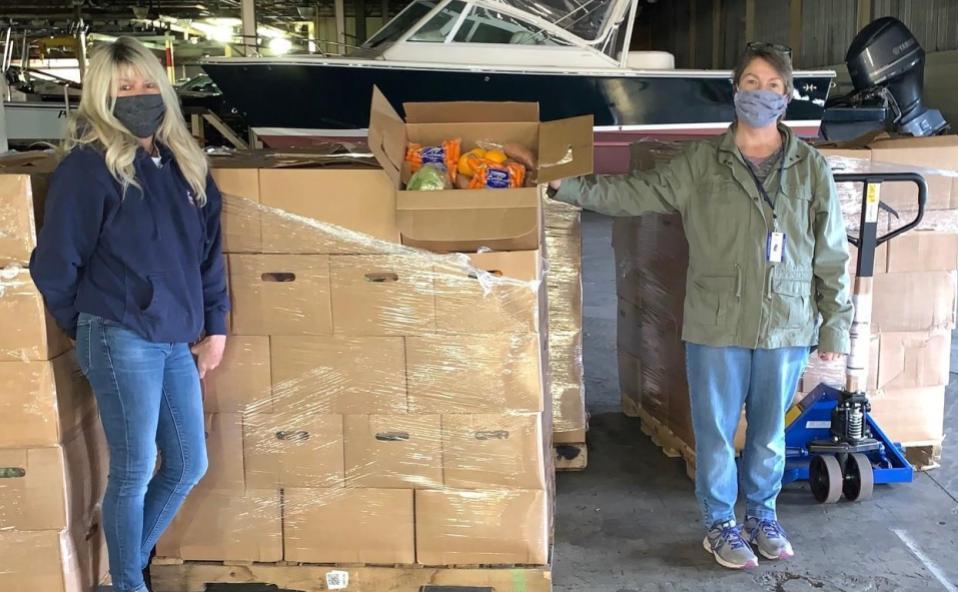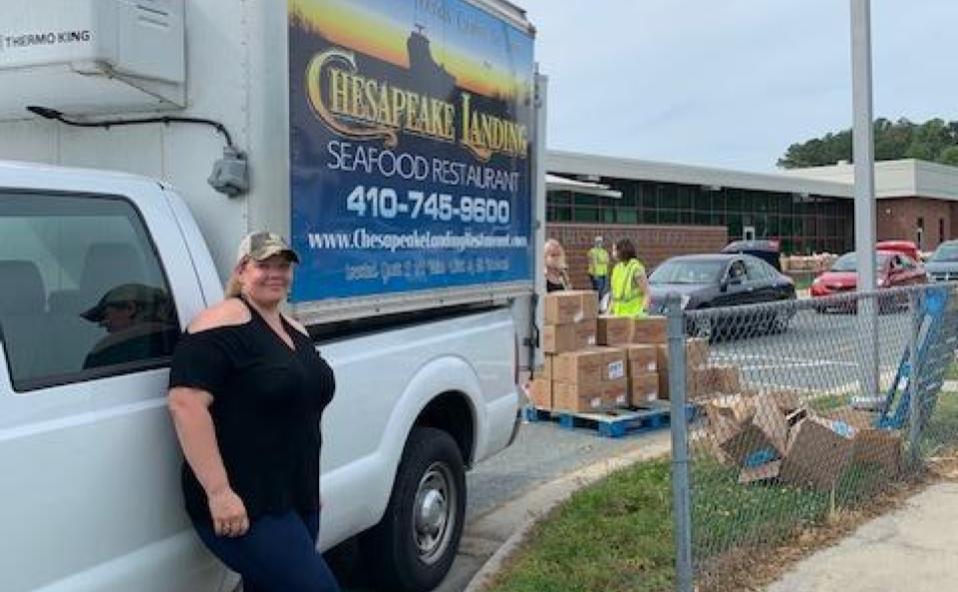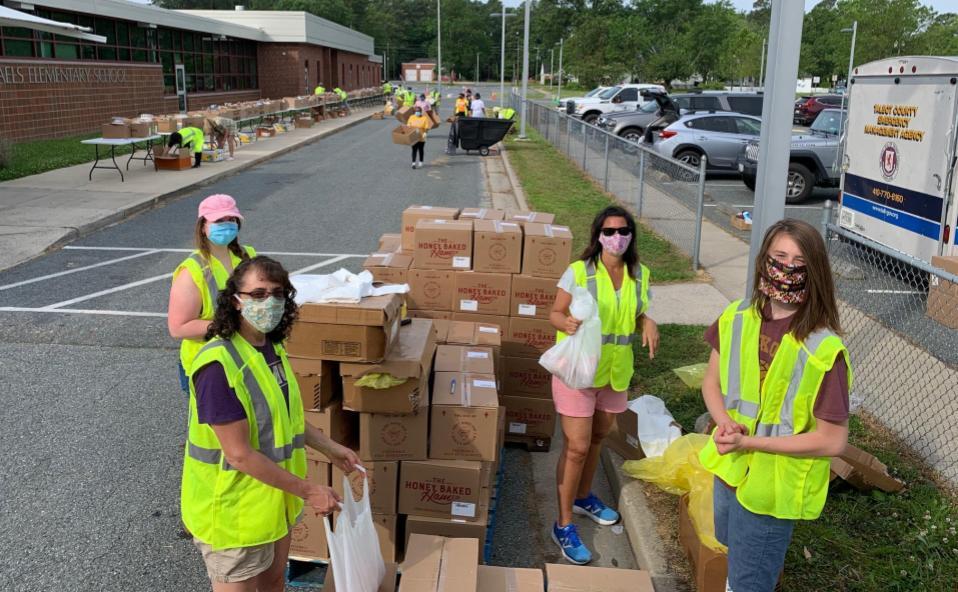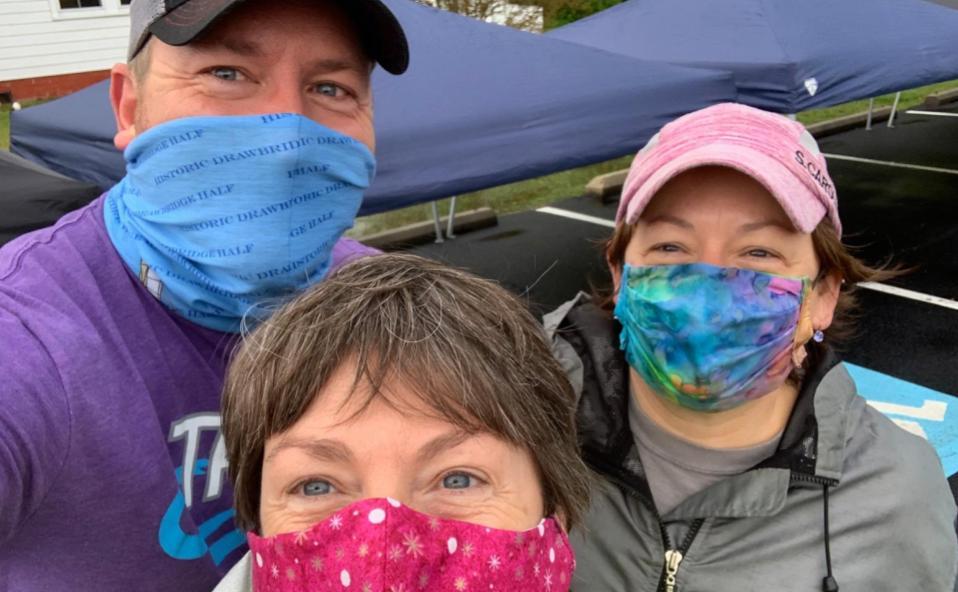In March 2020, when Governor Hogan issued the Stay at Home Order in Maryland, the Talbot County Emergency Operations Committee (EOC) knew that providing sufficient food was going to be very important in making residents feel safe and stable during the COVID-19 pandemic.
“We knew that the County already has a hunger issue during the good times,” says Jan Willis, who manages the Emergency Operations Committee Feeding Task Force and serves as coordinator of the Local Care Team for Talbot County, “But to see the explosion of need with the huge increase in unemployment, especially in the service industry, has been staggering.”

L-R: Teddy Bear Fresh owner Mary Salins with Jan Willis, Coordinator of the Local Care Team for Talbot County.
Before COVID-19, the poverty rate in Talbot County was 11 percent and 28 percent of residents lived just above poverty level and were employed. When COVID-19 happened, those living below poverty or just above the poverty level totaled 39 percent or 17,000 people.
“This was an unprecedented event that affected so many people,” Willis adds. “The complications were that many were not receiving their unemployment benefits and had no money for food.”
In 2014, the Talbot Family Network formed the Talbot County Hunger Coalition in partnership with existing food pantries, churches, and other agencies. This organization has worked to raise awareness of the issue of hunger in Talbot County and has helped to raise funds for the network of food pantries already operating in the County.

Erin Spurry of Chesapeake Landing
Catherine Poe serves as Chair of the Talbot County Hunger Coalition, “By establishing the Coalition, we have been able to coordinate Talbot County’s food services and thank God we had the structure in place when COVID-19 hit,” she says.
Talbot County has nine nonprofit organizations or qualified faith-based organizations that partner with the Maryland Food Bank– Eastern Shore,according to Regional Programs Director, Jennifer Small.When the pandemic started, the Maryland Food Bank put into place a plan to meet the increased need. The Governor granted $3 million to the Maryland Food Bank to distribute to statewide partners within their service territory, which includes 21 Maryland counties and Baltimore City.
Additionally, the Maryland Food Bank partnered with several county-level emergency management service departments and committees to add additional financial support in response to COVID-19 impacts that would be experienced well into the fall. As a result of this partnership,Talbot County and Talbot Family Network’s with the Maryland Food Bank Eastern Shore, Talbot County was able to purchase a direct shipment of 23,000 pounds of shelf-stable palletized food which can be distributed through the county’s 11 permanent food pantries. The food is packed into 30-pound boxes that are then distributed to Talbot County food pantries, used in neighborhood distribution events,or delivered to support the needs of families in quarantine due to COVID-19.

Volunteers preparing for the Pantry on the Go food distribution in St. Michaels.
The Maryland Food Bank also joins with partners in the County to handle emergency community needs as they arise. These partners include emergency pantries, youth programs (Care Packs), mobile pantries on the go currently operating as drive-through pantries (Scott’s United Methodist Church and Union Baptist Church), and The Emergency Food Assistance Programs (TEFAP) (Neighborhood Service Center).
For mobile pantry partners, the Maryland Food Bank builds the orders that the partners receive for a community distribution event. These include shelf-stable dry goods, produce, beverages, meats, breads,and pastries. For other non-mobile specific partners, they order from an online menu in which they have a 24-hour turnaround time from order to delivery of food to their organizations.
“Since COVID-19, we have seen a greater need than we have ever seen before,” Small says. “Statewide statistics for the Maryland Food Bank reveal that 4.4 million pounds of food were distributed in April 2020, which is double the amount of food distributed in April of 2019. In addition, there has been a reported 40 percent increase in new clients visiting pantries on the Eastern Shore, clients who have never used the Food Bank before this spring.

L-R: Jason Chance of Tricycle and Run, Jan Willis,Coordinator of the Local Care Team for Talbot County, and Julia Cohoon, Feeding Operations Assistant.
“We are fortunate to have partners like Talbot County and the Talbot Family Network to help us meet needs in creative ways like hosting drive-through food pantries while exercising strict safety measures to better serve our local constituents during such a challenging time,” Small adds.
The U.S. Department of Agriculture’s (USDA) Farmers to Families Food Box Program is a new program that contracted with the Maryland Food Bank during the COVID-19 pandemic. The program came together quickly through the USDA after supply chain disruptions began and farmers started plowing under vegetables as a result of having large amounts of excess produce.
“Through this program the USDA helps to support farmers and suppliers who in turn provide Food Banks with produce, meat, and dairy products, helping to get food onto the tables of food-insecure families; nutritional items, which can be costly when having to be purchased,”Small explains.
Easton-based Teddy Bear Fresh, was one of 200 distributors who were selected to participate in the USDA program, distributing 3500 boxes of produce a week to food pantry locations and pop-up food pantries on the Eastern Shore. The Salisbury Branch of the Maryland Food Bank Warehouse receives 1,500 boxes. Some 1,000 boxes are distributed directly to Talbot County food pantries through the Talbot County EOC, and 1000 boxes are shipped directly to Caroline County through the County Commissioners.
This program has enabled Teddy Bear Fresh owner Mary Salins to create 18 jobs for people packing the boxes. A total of 21,000 boxes were delivered in the first six weeks of the program.Each 25-pound box contains lettuce, potatoes, sweet potatoes, carrots, cabbage, apples, onions, and oranges.All food included in the produce boxes is produced in the U.S.Teddy Bear Fresh Produce was recently selected to participate in the next period covering July 1 through August 31, 2020.
“We have been in the food distribution business for 11 years, Salins says. “Because Teddy Bear Fresh has been involved for years supporting the Maryland Food Bank and the Talbot County Care Packs program, we already had the relationships and knew the need was there.
“We put a lot of love in our boxes. It’s an honor to be picked to provide this service representing the Eastern Shore in these efforts, but it’s the food pantries who are the real heroes here as they are getting the boxes to the people in need,” she adds.
Salins is working with several local farmers to incorporate local produce into the boxes, including kale and collards, depending on its availability during the growing season.
Trish Payne, Executive Director, St. Michaels Community Center, one of Talbot County’s food pantries and meal distribution sites, states, “St. Michaels Community Center is very grateful to have the opportunity to help anyone in need during this unsettling time. We’re only able to fill the needs because of the tremendous support we’ve received from our community, the assistance we get from being a member of the Maryland Food Bank, assistance in fresh produce received from the USDA, meals and food donations from Gourmet By the Bay, Graul’s Market and generous donors who have helped us help so many.”
COVID-19 is going to have lasting effects in the months to come Small predicts. “We are estimating that in September and October, the need will still be there,” she says. “The financial impact on the Maryland Food Bank resulting from increased purchasing and increased food costs of more than 30-50%, has been measurable.
“Before COVID-19, $1 provided three meals and that has changed since COVID,” she continues.“Because food donations have declined as retailers are no longer seeing the excess product that is typically donated to us, monetary donations to the Maryland Food Bank continue to be important and we will continue to rely on county-level support to meet these needs.”
Increased awareness of hunger issues in Talbot County is one positive to come from the community’s response to the COVID-19 pandemic.
“It has been so heartening to me to see the responsiveness of Talbot County’s food pantries and how the community has recognized the importance of food in making families feel stable and safe,” Willis says. “During this time, volunteers logged in a total of more than 1,271 volunteer hours related to food distributions. The foresight of Talbot County – specifically Emergency Operations Director Clay Stamp – to bring food on as early as they did helped to stabilize Talbot County early in this crisis.”
Stamp reflects on the community response, “We are more than three months into the COVID-19 crisis, and I couldn’t be more proud of my Talbot County community, both in my public safety role and as a citizen. I have and continue to be amazed at the selfless commitment of so many for those in need.”
Don’t miss the latest! You can subscribe to The Talbot Spy‘s free Daily Intelligence Report here



Write a Letter to the Editor on this Article
We encourage readers to offer their point of view on this article by submitting the following form. Editing is sometimes necessary and is done at the discretion of the editorial staff.